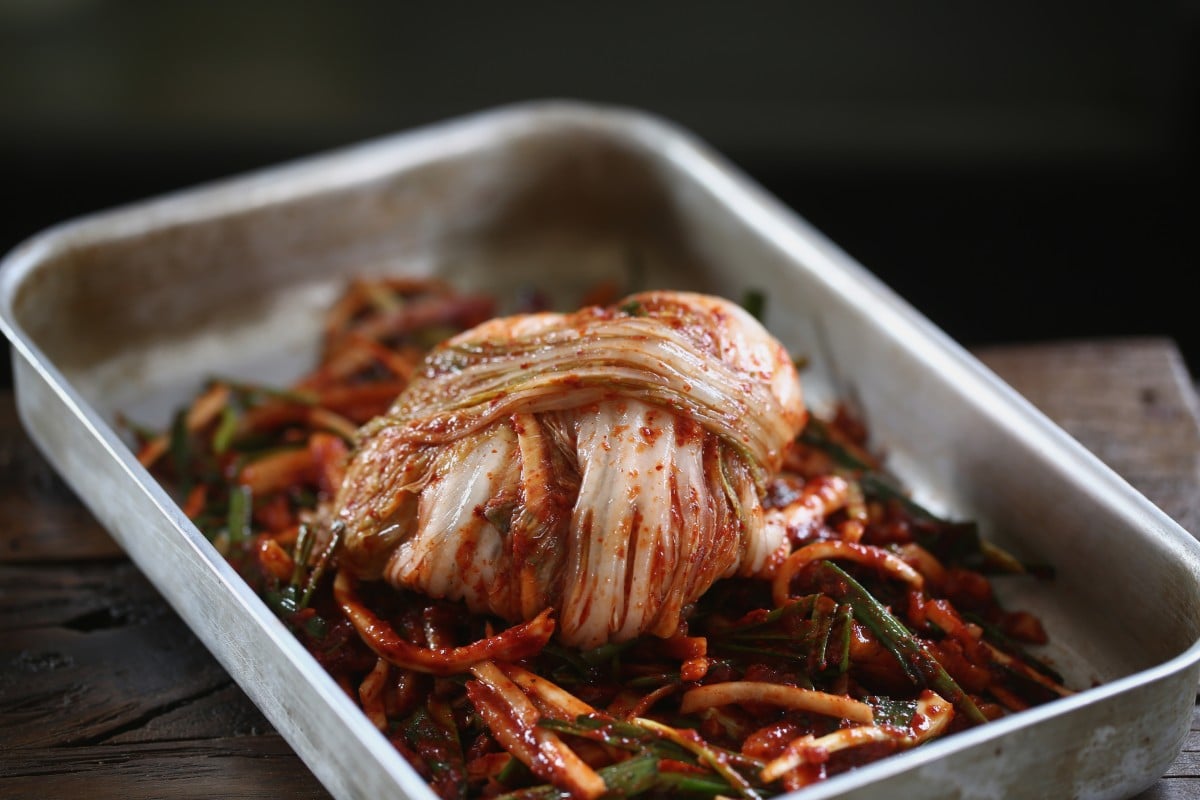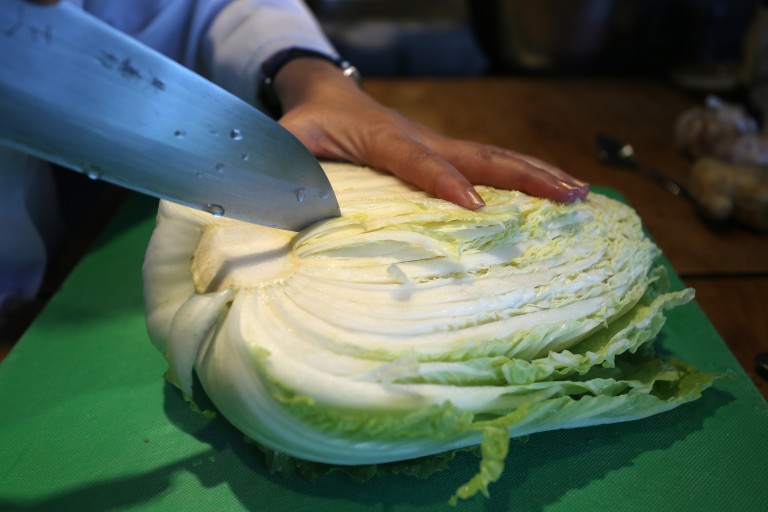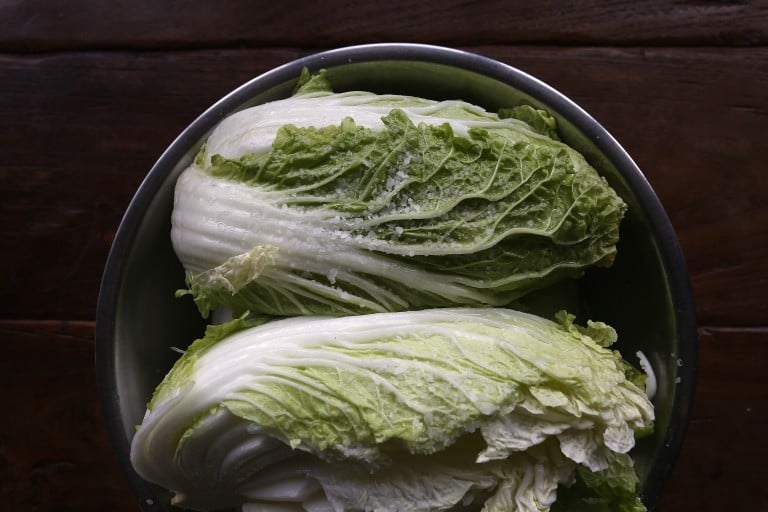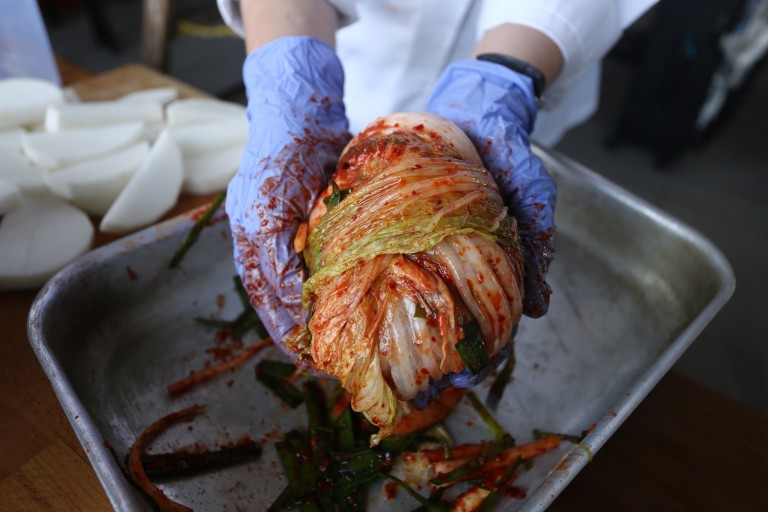
In Korea, one of the traditional activities that takes place as winter sets in is kimjang (also spelled gimjang). Back in the old days, before refrigerators were invented and when you had to ensure you had enough food to last until spring, family and friends would get together to make enormous amounts of kimchi. This would then be placed in vats partially buried in the frozen ground, which would help to preserve the contents.
These days, with fresh ingredients available year-round from across the world, kimchi can be made any time. It is still best made in winter, though, when the baechu (napa cabbage) and mu (daikon) are large, heavy and sweet.
If you live near a Korean grocery store, make a special trip there to buy imported cabbage and daikon, instead of buying them from a supermarket, because you want the short, fat, heavy specimens of both vegetables. While you are there, you should also buy the gochugaru (Korean chilli flakes), salted shrimp (tiny shrimp in brine, sold in jars), bellflower roots (sold in packs in the fresh vegetable section), anchovy sauce (it is more pungent than Thai and Vietnamese fish sauces), glutinous rice flour and Korean pear. If you can’t find bellflower roots, use carrot – peeled and cut into thin matchsticks – instead.
In the spirit of kimjang, this recipe makes a lot of kimchi. I keep some for myself and give the rest to friends. The kimchi base is enough for 3.5kg to 4.5kg (7¾-10lbs) of cabbage. If you use less cabbage, set aside some of the kimchi base and use it to make other types of banchan (side dishes), or store it in the fridge for another batch of kimchi.
Sufficiently salting the cabbage is the essential first step – leave plenty of time or the salt won’t penetrate and soften the leaves. If the cabbage isn’t sufficiently salted, the kimchi will turn rotten. I use about 40 grams (3 tbsp and ½ tsp) or more of salt per kilo of cabbage.
Traditional Korean kimchi makers believe that using bare hands to spread the chilli paste over the cabbage leaves adds more flavour but I wear disposable gloves – they prevent the paste from staining your fingers. And instead of putting the kimchi into traditional earthenware containers, modern kimchi makers are using plastic containers with lockable lids, which fit more compactly into the fridge. You can also use wide-mouthed glass jars.
The kimchi can be eaten fresh (when it's almost like a salad), lightly aged (so the leaves are still slightly crisp), or aged for longer (when it's strong and pungent). If the kimchi gets too strong, use it to make dishes such as kimchi fried rice or kimchi pancakes.

Slice the stem end of the cabbage, cutting about 4cm (1½ in) deep. Grasp the cut parts in your hands and pull apart the cabbage into two halves (don’t cut the cabbage from root to tip, or you’ll end up with a lot of tiny pieces). Place the cabbage halves cut-side down on a cutting board, make a 4cm (1½ in) cut in each stem end and pull apart the cabbage so you now have four quarters; repeat with the second cabbage. Rinse the quarters under running water, making sure to wash between the leaves.

Put the cabbage quarters into a large bowl (you probably need two or three) and sprinkle 150-180g (¾ cup to ¾ cup and 2 ½ tsp) of salt over the pieces and between the leaves. Leave the cabbage at room temperature for several hours, or overnight, occasionally turning over the pieces in the bowl. The salt will draw the moisture out of the cabbage and soften the leaves. The cabbage is ready when you can bend the leaves in half without them snapping – test a few leaves on each quarter.
Drain off the liquid in the bowl(s), then fill it with fresh water. Plunge the cabbage quarters up and down in the bowl so the water gets between the leaves, then drain. Repeat this twice, then pull off and taste one or two small leaves from each quarter – it should not taste salty. If it does, repeat the rinsing process. Drain in a colander and tightly squeeze the cabbage quarters with your hands to remove as much liquid as possible. Leave the cabbage in the colander so the pieces can continue to drain.
Put the glutinous rice flour in a medium-sized pot and add 240ml (1 cup) of water. Use a small whisk to stir the mixture. Place the pot over a medium flame and stir constantly until the mixture is translucent and thick. As the whisk is drawn through the mixture, it will leave a brief track mark on the bottom of the pot. Whisk in the sugar, then set aside to cool.
Roughly chop the garlic and ginger and place it in a small blender or food processor. Add the salted shrimp and process until all the ingredients are finely chopped. (Or you can hand-mince the ingredients.) Put the ingredients in a bowl and add the rice-flour mixture, the gochugaru, the anchovy sauce and 10g of fine sea salt. Mix thoroughly.
Peel the Korean radish, then cut one-third of it into thin matchsticks. Cut the remaining radish into two-bite pieces. Cut the bellflower roots, spring onions and chives into 2.5cm (1 inch) lengths. Peel the Korean pear and cut it into thin matchsticks.
Put the matchstick pieces of daikon into a bowl and add the bellflower roots or carrot, spring onion, chives and pear. Add enough of the paste mixture to thoroughly coat the vegetables and mix well.

Place one cabbage quarter cut-side up on a work surface. Spread a scant amount of the chilli paste-vegetable mixture over each leaf, spreading it from the base of the leaf to the tip. It should lightly cover each leaf, with more at the base and on the larger leaves. After you’ve coated each leaf, wrap the cabbage into a tight ball, folding the outer leaves over the base. Place the kimchi into a container and finish with the remaining cabbage quarters and filling, using all the vegetables and adding more paste, if necessary (you might not need it all). Tightly pack the kimchi into the container, leaving about 2.5cm (1 inch) of head space.
After preparing all the cabbage, put the two-bite pieces of radish into the bowl that held the chill paste and vegetables. Mix to lightly coat the radish with the chilli paste remaining in the bowl; if there’s not enough, add more paste. Pack the radish in the container(s) of kimchi, using them to fill any gaps between the cabbage.
Seal the containers with the lid and leave at room temperature for about two days (for a light fermentation) or longer, if you like it more pungent. Occasionally open the containers, to release any gas. Refrigerate the kimchi and cut it up as you want it, using clean tongs and scissors. Do not put any cut-up kimchi back into the main container, or it might contaminate it.
With the leftover chilli paste, you can make quickly cured banchan (side dishes). Blanch bean sprouts for about 10 seconds in boiling water, then drain and squeeze out the excess liquid. Mix with enough chilli paste to lightly coat the bean sprouts. This can be eaten immediately.
For cucumber kimchi, trim off the ends of the vegetable, then cut into 1cm discs. Sprinkle the pieces with salt and leave until soft, mixing often. Drain off the liquid in the bowl. Rinse the cucumber with water to remove the excess salt, before squeezing out the excess liquid. Mix with some chilli paste to lightly coat the pieces. This can be eaten immediately, but tastes better if you let it age in the fridge for about eight hours.